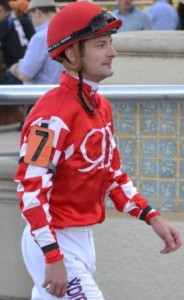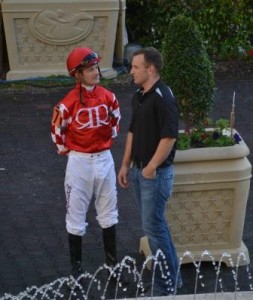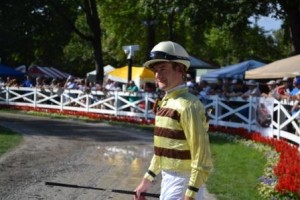Meet Julian Leparoux – A Cracking Good Rider
Continuing with our popular “Meet The People” series, I recently sat down with Julian Leparoux in the jockey’s room at Gulfstream Park. Julian emigrated from France to the USA in 2003 and began riding thoroughbred horses as a jockey in 2005. He made a big splash in 2006 by setting records for an apprentice in terms of wins and earnings. As a result of these feats, he was awarded the Eclipse Award for Outstanding Apprentice Jockey that year.
Over the years he has been labeled as an excellent “turf rider,” “polytrack rider,” “gate rider” … and a few more that he mentions below. But in the end, as I discovered with many of Julian’s responses … it really all depends on the horses he’s riding.
How did you get started riding horses?
My dad was an assistant trainer in France. I grew up around horses all my life. I started riding at eleven and I did show jumping. I started riding racehorses around eighteen. I galloped horses one year in France, and then I came to the States in 2003 and started riding in 2005. Then 2006 was an amazing year, I won 403 races and was top apprentice.
Did you think it would be that easy when you came to the States?
When I started riding, I was thinking at least 45 wins a year would be great … I had very low expectations. Then everything blew up at Turfway Park, where I won 167 races in 3 months. So in the first month I got more winners than I was expecting (for the entire year). It was like a snowball, it kept going and got bigger. It was a great year.
Tell us about your conversations with trainers in the paddock minutes before a race. What do you talk about?
It really all depends … on the trainer and the horses. Some trainers and horses you already have a relationship with, so they don’t have to tell you much about the horse. If it’s a horse you’re riding for the first time, it’s very helpful when they tell you the horse’s bad habits. Like “in or out”, “rank,” or “lazy” … all the stuff that will help you.
Other than that, “just ride your race” is the best thing a trainer can tell you. Sometimes too many instructions can get you confused, like when they tell you five different things. A little bit of information is good, but not too much.
For each trainer that you ride for, do you have a mental checklist of their particular likes or dislikes?
You know what the trainer likes, but you also know the trainer likes to win. So you’ve got to do whatever is best to win. And sometimes it’s not how they wanted to win it, but if you bring home the winner, then that’s good. They don’t like to lose doing what they don’t like you to do. When you ride for Christophe Clement he likes to save ground around the turns and you know that before you ride a race for him. And that’s good to know as a jockey. So with him, I know if I get stopped because the race didn’t go as planned, he’s not going to be as upset, because I tried to do what he wanted me to do.
How do you “move on” when a race doesn’t go well, or at least live up to your expectations?
It’s your job to go and ride the next race, probably for different people, so even if something bad happened in the race before, you have to focus on the next race. It’s not easy, and how you do it I don’t have the secret for that, but I guess you just have to stay focused. It’s the same thing as when you win. If you win a $1 million dollar race, that’s great, but you do have to ride the next race and that’s just as important as the one you just won. So you’re happy you won the race, but now you’ve got to do the same thing with the next horse.
As an example of a race that didn’t go well, at least at the start, can you talk about Java’s War and the Bluegrass Stakes at Keeneland?
After the gate broke, it wasn’t that I didn’t think I had any chance, but I knew it was going to be tough for sure. Kenny (McPeek) already told me he wasn’t a good gate horse, and he’ll probably be back a little bit, but he just walked out of the gate, and I was like “Ohhh no.” But I thought, just get him to relax, and we’ll make one run. At the 3/8 pole I thought I’m going to run good, at the quarter pole when he really got going, I thought maybe we’d get 2nd, at the 1/8 pole I knew I was going to win.
[Check out the race replay below. Java’s War is #4. Or, just look for the horse who is”absolutely last after that poor start” as the track announcer (Kurt Becker) calls it. Also, check out the name of the horse he passes at the finish line. Hint: He went on to win The Belmont Stakes less than two months later.]
Sometimes a trainer will tell you before the race, “Just the ride break.” What that means is whatever happens at the break, just ride your horse. If they don’t break good, you cannot just make a big middle move. Say you had a plan A, where you wanted to be laying 5th or 6th in a 14-horse field. If the horse doesn’t break well, you don’t want to say in the middle of the backside, “I’m going to move up to 5th or 6th now” … it doesn’t work like that. You have to go to Plan B, stay where you are, and adjust.
You have to have more than one plan, that’s for sure. Sometimes you want to be back early in the race with some horses, but let’s say he breaks good, and you’re laying closer than you expected, well that can be different Plan B.
Do you feel that you’ve been labeled (right or wrong) with any particular riding traits?
People give you those traits, so I guess for me, coming from behind on the turf or polytrack is one example. But it all depends on what kind of horse you’re riding. As an apprentice I was riding a lot of European horses that need to be covered up and have a strong finish, so right away they told me I was turf rider and good at coming from behind. Then Keeneland put in a Polytrack and I was leading rider, so they tell me I’m a Polytrack rider. Before I was riding for Steve Asmussen, nobody thought I was a 2-year old rider, and then because I was winning the 4 ½ furlong races at Keeneland for him, now I’d become a good “gate rider.” So it all depends on the horses you ride.
Can you tell us about the process involved with deciding which horse to ride when you have options in an upcoming race?
It really all depends, there are so many scenarios you can have. Usually it’s teamwork with your agent, but I like to give my agent a little more freedom, because that’s his job and I pay him for that. Unless it’s two horses that are very similar, then he might ask me what to do? Sometimes I might work one in the morning and then report that to him.
How much of a factor is the trainers involved with the horses you’re deciding between? Especially when one of them is a trainer you ride for a lot.
That’s actually a great question. When you’ve got two horses that on paper are about the same price, you’re definitely going to ride for the trainer you ride the most.
Ok, so what if they’re not the same price, say one is 2-1 and the other is 10-1 … and the latter is the for the trainer you ride for often?
That depends. Sometimes, because of the trainer, you’re going to ride the 10-1 instead of the 2-1 horse. But if you’ve got a good relationship with the trainer, you might tell him I could ride a favorite in the race … so can you let me ride the other one? My agent is usually doing that work for me.
Let’s talk about a specific horse, Sparkling Review, a filly you rode to two stakes wins for Ben Colebrook in 2014.
After her race at Kentucky Downs, Ben told me, “I’ve got this filly for you. She’s going to run in a stakes race at Keeneland.” And in that race I could have been riding for Kenny McPeek, and I ride a lot for Kenny, so it’s one of those deals we were talking about. I told Ben, “Let me work the filly in the morning and I’ll let you know.” So one morning I went to Keeneland and breezed Sparkling Review on the turf, and I got off the filly and my agent was standing there and I said, “I’m riding this one!” So, Ben came back to the barn, and my agent said, “We’re good. We’re riding this one.”
She’s a very nice filly. You always have to be careful in the transition from 3 to 4 years old, but I think she can be a Grade-1 filly this year for sure. I won with her at Keeneland, and she was very impressive, then she was even more impressive at Churchill the next time. She’s starting again on March 7 at Tampa, so it’s nice that she’s coming back to the races and I’m looking forward to it.
What are your favorite racetracks?
My two favorite places are Saratoga and Keeneland, because it’s two tracks where the racing fans are just great. You go to Keeneland and everybody loves the sport. You go to the track any day of the week and you’ve got people there. On opening day in the spring, it could rain or snow and it will still be fun. And Lexington is full of horse racing everywhere you go.
The same thing in Saratoga, you go six days a week and even on a slow day, you’re still going to have a crowd there. When I came to America and I saw my first Travers Day, and I was an exercise rider at the time, and I could not believe that people slept on the street just to have a picnic table! I was riding my horses at 5:00 in the morning and going to the track and seeing people laying down. It was a crazy experience to me … I thought they were crazy. But, it’s fun to see the people that love the sport and it definitely feels good.
I saw you riding down at Kentucky Downs back in September, tell me about your experience there.
You’ve got to give a lot of credit to the president, Corey Johnsen. He does an incredible job. A couple of years ago when I first went there I thought this place was fun to ride. And now they have more money and they’re doing the right things. I talked to Corey in January and he said they are changing the rail and they’re going to make the turf even better next year. It’s a great atmosphere, it’s relaxing, and now that the money is there it’s great for us too. Even before they had the money, it was still a fun place for us to go and do something different. I like the place very much.
Finally, can you tell us about your wife and where you call home now?
My wife is Shea and we’ve been married for two years. She worked for eight years at Disney, including a cruise line, Hong Kong Disney, Paris Disney, and Disneyland in California. We have a house in Dania Beach and one in Kentucky. No kids yet, but we want some. After Florida, we go to Kentucky for Keeneland and Churchill Downs, then Saratoga, and then back to Kentucky for September through November.
Shea wasn’t used to the moving around part, three states in a year. But, she’s adapting to it. She likes it in Florida. Since we have a home here and in Kentucky, we’re blessed to go home everywhere we go, except Saratoga where we rent a place. It’s not easy to move, but it’s easier when you have a place.
Maybe rather than trying to place labels on Julian as a good “Gate rider” or good “Polytrack rider,” people have finally realized that Julian Leparoux is simply put … “A Cracking Good Rider.”
Thank you Julian for taking the time to share with us your thoughts about riding. We wish you and Shea the best of luck in the future.





4 comments on “Meet Julian Leparoux – A Cracking Good Rider”